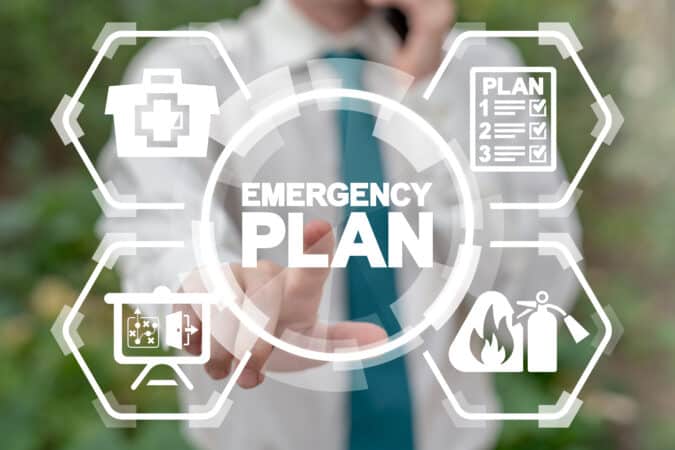How would you escape your RV in the event of a fire? Don’t wait until it’s too late, complete an emergency escape plan for your RV now and practice it yearly.

Fire preparedness, although of the utmost importance, often goes overlooked for some reason. In the event of a fire, stress, confusion, and panic can all affect your thought process. This is not the time to be figuring out which window is the fire escape or how to operate your emergency exit window.
Of course, taking fire prevention measures is the best way to prevent a fire but unfortunately, RV fires do happen and people are too often not prepared to react. Having working fire extinguishers and fire alarms is a must (but just the starting point in your preparedness).
Your RV, by law, is designed with some fire egress components such as escape windows, hatches, and second doors. Most of us have probably seen the red handle on that one window and never thought any more of it. Although very simple to operate by design, it is important to actually practice the operation.
Unlike a house, RVs are not large spaces that are difficult to clear and account for people in the event of a fire. Even still, it is critical that you have a plan of escape should the worst happen.
What is an Emergency Escape Plan?
Remember in school when you would have fire drills? It wasn’t just a way to get out of class for a bit, it was a way to etch into your head what you were going to do in an emergency situation.
When we practice and repeat things, our brain stores that information, and those actions. If needed in a real-life situation we will react in the manner we have taught our brain. What may seem pointless and silly at the time could be life-saving. This is particularly important in the case of young children.
An RV fire escape plan details what should happen in the event of such a situation. It will have some general information and some specific to your RV.
At a minimum, your fire escape plan should include:
- All the locations of exits including doors, escape windows, and hatches
- Headcount (don’t forget the pets)
- Emergency meeting point
- Locations of fire extinguishers and first aid kits
- Emergency phone numbers
- A checklist of safety precautions to take
For certain emergency tasks, it’s a good idea to assign someone to that specific task. For example, shutting off the propane supply to the RV. Keep in mind, that this assigned person may not be with you on all trips or may be injured in an emergency situation.
Your plan should be easy to read and kept somewhere easily accessible – ideally posted in the RV perhaps near an exit. Only basic details are needed, don’t overcomplicate it.
RV Emergency Exit Windows
RVs, like houses, generally have multiple windows. Not all of these windows, however, can be used as emergency exits. Some will be too small for egress. That being said, any window that is large enough to crawl through should be noted on your RV fire escape plan.
Most RV windows slide open horizontally, this means the opening is only half the length of the window. In an emergency, glass can be broken but the metal framing of the window may obstruct the opening. Then, of course, there is the possibility of injury from breaking or crawling through a broken window.
This is where the escape windows installed by manufacturers differ. They open by flipping up, resulting in a full opening with no sharp edges to worry about. Different RVs use different styles but they all will have a red handle or latches. The window is unlocked and pushed out so it flips up.
They are easily identifiable by the red handles and/or latches they use. There may also be a decal on or near the window with operating instructions for the window. These decals along with the EXIT decals on used RVs may no longer be in place. If the EXIT decal is missing, have a new one installed.
The window will not fall out so you can, and should, practice using it. Have your kids practice opening the window and even exiting through it. The window height, especially for kids, might be high so having someone outside to help them is best. You may also consider having a small step or ladder under your exit window for easy egress.
Escape Hatches in RVs
Some RVs, in particular truck campers, use escape hatches for emergency exits. These are generally mounted on the roof and allow for easy passage through for adults.
As with the emergency windows, there are a few different variations. The most commonly seen setup is a handle that is pulled down allowing the hatch to be pushed open.
These hatches should also be tested for easy operation and you should practice exiting through them. In the case of a truck camper, you may not be able to access the roof ladder if there is a fire. This means the roof and hood of your truck may have to be used to clear the area.
Some RVs use a hatch in place of a window in certain floor plans. These hatches operate in the same way as a window. It’s of particular importance to have kids practice using these hatches located in bunk areas. RV fire escape for children is critical. Most RV floor plans have the children sleeping quarters at the opposite end of the RV from the main quarters. If there were a fire in the main living area, you want your children to be confident in getting out.
Emergency Exit Doors
Many RV floorplans have two doors for convenience. It’s a good idea whenever you park your RV to make sure both doors can be opened and exited. People often drop the stairs on only the main door when they set up their site. Although it isn’t a far jump to the ground in an emergency, it’s a good practice to have both sets of stairs lowered and ready for use.
Most coaches use dropped stairs as the floor is often higher. This means many of the emergency doors are quite high off the ground. In this case, a set of emergency stairs or a ladder is often utilized.
Understanding how yours works and checking it regularly for operation is a must.
Exiting Your RV in an Emergency
RVs burn fast! Anyone who has seen an RV fire has no doubt been amazed at how fast it was completely burned. In the event of a fire, you have very limited time to get out of your RV and to a safe location.
The key to the exit is quickly but calmly. Rushing can cause added confusion or injury to an already scary situation. Practicing your escape plan will lessen the panic in the real situation.
The first items in a fast safe exit actually happen before any emergency. Since speed is key, there are a few things to consider for a worst-case scenario. First, and most importantly, have working fire and gas detectors! If you wake from smelling smoke or hearing your RV breaking apart this has cost you valuable time.
Once it’s go-time you need a quick path to safety. Get in the habit of not having lots of clutter around your RV. Specifically, keep the floor free of tripping hazards. Once to get to the exits, you want a fast easy exit. Park your RV so that exits, including fold-out windows, have room to open and allow easy egress for an adult.
With people and pets at the exits, quickly and calmly exit the RV. Part of your escape plan may include the order in which people will exit the RV. For example, if you have multiple people or everyone at the same exit: kids first, older people or people with disabilities, then remaining persons. Your plan will depend on your family.
Ideally, the first person out can be in charge of shutting off the gas supply if safe. If not, then the first person confident in doing so.
Once outside and at a safe location, make sure everyone is there and no injuries were sustained in the exit. Having a first aid kit as part of your ditch bag allows you to address any minor injuries until help arrives.
Have a Ditch Bag
A ditch bag, also known by different names such as grab bag, in this context isn’t for running away from home. It will contain the important things you will want to have with you when you leave your RV.
These things should be just the important stuff. You don’t want to be wrestling a suitcase of stuff out the window. You may have something specific to add to yours but the common contents will include items such as these:
- Important medication
- Basic first aid supplies
- Personal identification
- Emergency contacts
- Extra credit or debit cards
- A small amount of cash
The location of your ditch bag is debatable. Near an emergency exit seem like a good place, however, it is possible that won’t be the exit used. Centrally located in the RV is another spot that makes sense. Let everyone in the RV know where it is located so it can be grabbed by anyone.
Some people choose to have their ditch bag in their tow vehicle instead. In the case of an emergency, if it is safe to do so, moving your tow vehicle to a safe location is a good idea. Extra keys for your vehicle are another item to add to your ditch bag.
We all hope to never have to experience an RV fire but we all should be prepared to experience one. The time required to complete an RV fire escape plan, put together a ditch bag, and practice your emergency exit is minimal. In the event of a fire, those seconds from noticing it to outside allow no time for important decision making.
If you don’t already have these things in place before your next trip, take the time and complete an escape plan. The thought of losing your RV is a dreadful one but the thought of lost life is unthinkable.



I have a 4 section 12’ ladder folds into a 6’ step ladder that I put outside the bedroom escape window as we are octogenarians and would definitely hurt ourselves dropping 5 1/2’ to the ground after squirming through that window, been doing that since we had our 16 year old motorhome that I had to pry open the escape windows with a screwdriver from the outside. CHECK YOU ESCAPE WINDOWS TO MAKE SURE THEY WILL OPEN!!
Thanks, for the EMERGENCY ESPACE PLAN AND SOMEHING TO REALLY THINK AND TALK ABOUT!